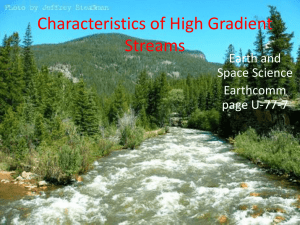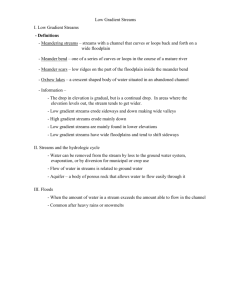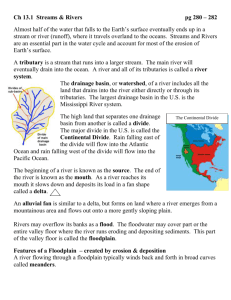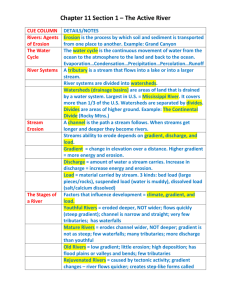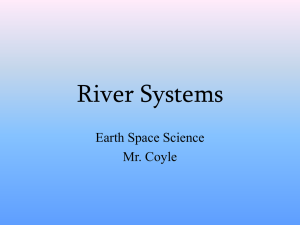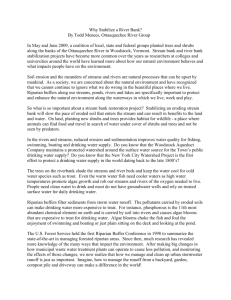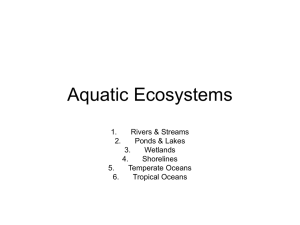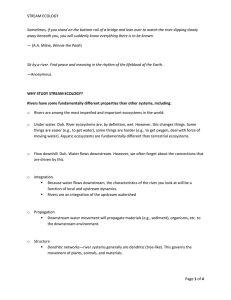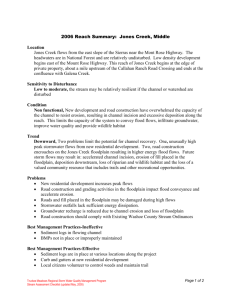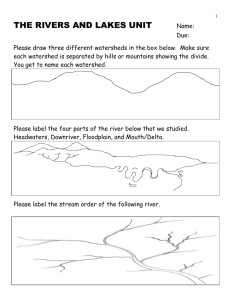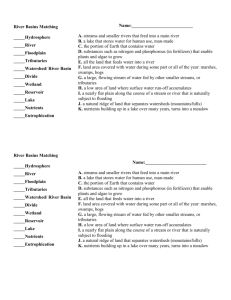We discussed the importance of rivers for holding water
advertisement
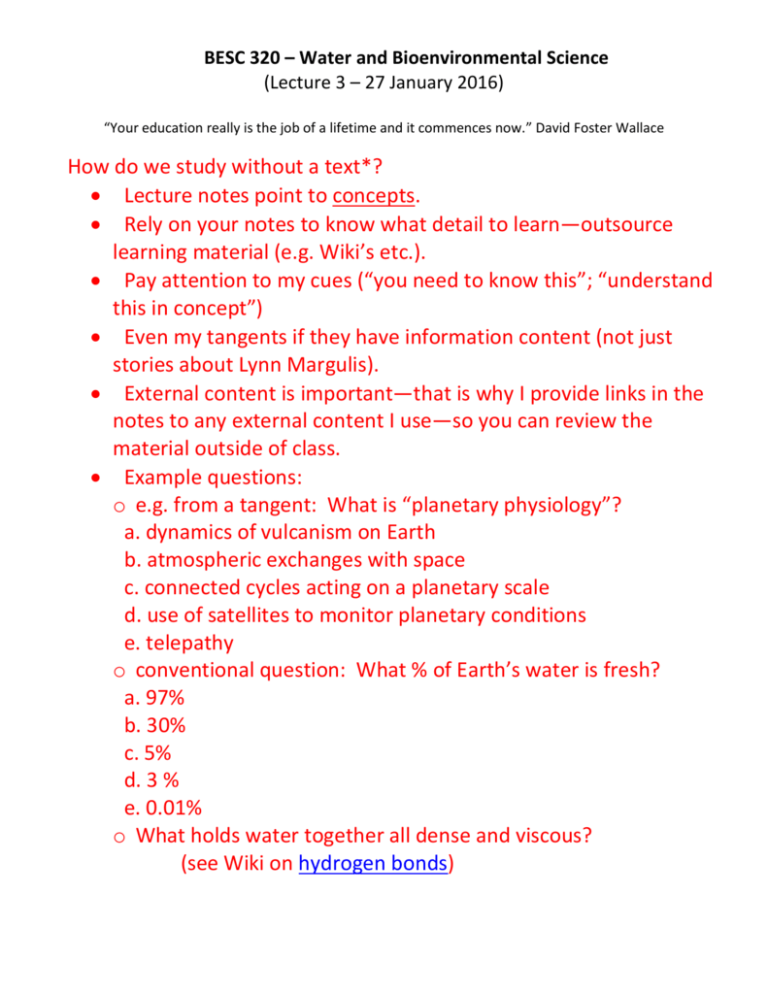
BESC 320 – Water and Bioenvironmental Science (Lecture 3 – 27 January 2016) “Your education really is the job of a lifetime and it commences now.” David Foster Wallace How do we study without a text*? Lecture notes point to concepts. Rely on your notes to know what detail to learn—outsource learning material (e.g. Wiki’s etc.). Pay attention to my cues (“you need to know this”; “understand this in concept”) Even my tangents if they have information content (not just stories about Lynn Margulis). External content is important—that is why I provide links in the notes to any external content I use—so you can review the material outside of class. Example questions: o e.g. from a tangent: What is “planetary physiology”? a. dynamics of vulcanism on Earth b. atmospheric exchanges with space c. connected cycles acting on a planetary scale d. use of satellites to monitor planetary conditions e. telepathy o conventional question: What % of Earth’s water is fresh? a. 97% b. 30% c. 5% d. 3 % e. 0.01% o What holds water together all dense and viscous? (see Wiki on hydrogen bonds) Other Unique Properties of Water Clouds are white (increase albedo of planet) As for most substances, water becomes more dense as temperatures drop. Except as temperature drops below 4 °C water grows less dense and solidifies at 0 °C. Water has high molar heat capacity allowing it to adsorb and emit relatively large amounts of heat without a change in temperature Water has large latent heats of evaporation and freezing as a result of hydrogen bonds, with the result that phase changes of water are an important heat-transport vehicle Strong cohesion (surface tension) & adhesion (wetting), the balance of which makes for capillarity water (dyed) mercury What are some important consequences you can think of regarding water’s high cohesion and adhesion? More fun with the properties of water: cohesion, adhesion, capillary action and surface tension: http://science.jrank.org/pages/1182/Capillary-Action.html (Note the video at the bottom begins slow but gets good) Ponder: Why does rain fall in drops? Why not cubes? How does the former answer relate, abstractly, to this: Why do water droplets run together? How do trees hoist water to their limbs hundreds of feet above ground? How do sweating, panting and swamp coolers work to cool? Water physical sciences II (geology) Water, liquid and solid, covers more than 70% of world’s surface More than 370 billion billion gallons 97% salt—oceans 3% fresh—mostly (70%) ice, much groundwater (29%), 1% surface do the math: 0.00003 of the world’s water is “easy” Table of volumes—with the residence time—relates to potential sustainability of use Precipitation—the greatest part of residence and refreshment times Of course the local view has been even more ugly, recently: Hydrologic Cycle Be able to describe key components: Evaporates or transpires from land, water, organisms Condensation (dew or cloud formation) Precipitation (rain, snow) Storage (water bodies, groundwater, glaciers) Infiltration (movement of water into soil) Percolation (movement of water through soil to zone of saturation) Runoff (movement of water into rivers and water bodies) Solar energy drives the hydrologic cycle. Key concept: solar energy ultimately drives nearly everything, with water as the planet’s life’s blood. Dynamics at the Earth’s surface contained in watersheds The nexus of river forks point the direction of flow (e.g. also indicates the landscape gradient). See example topography at right. Note that things happening in one part of the watershed influence everything downstream (and often, below ground). The gradient also creates ecological diversity. Stream order—literally, the order in which streams occur from high to low gradient. Headwaters are 1st order, and the larger rivers that go to sea are typically 4th order or higher. Practice this on the map or on Google Earth. Low order streams—small size, rapid gradient change, fast flow, clear & clean (oligotrophic) water, carries few but large parent materials. High order streams are opposite the descriptors given for high order streams. Oligotrophic—few (but diverse) organisms feeding off limited nutrients in the water. Eutrophic—a true feast for many (but undiverse) organisms feeding off abundant nutrients in the water. Mesotrophic—intermediate state between the ends of the gradient defined above Stream geomorphology Gradient, pathway, architecture of flowing water. Sinuous paths are typical for high order streams. Floodplain is part of stream structure. Imagine a straight channel of water, 1m deep, 10 m wide, going straight to Houston. Think about what volume of water that channel holds. Now imagine a highly sinuous path with the same depth and width. How does that volume of water compare? Thus a major function of natural, reticulate, sinusoidal riverways is storage of water. When that storage capacity is exceeded, floodplains generally contain the remainder. A floodplain is the natural basin in a watershed that floods during times of seasonally high precipitation. Plants are highly adapted to flooding regime. Presence of floodplain prevents flooding elsewhere, such as major cities. vs. Channelization (local flood control, “pass the buck”) Straightening stream paths, often accompanied by concrete guides Pushes water quickly downstream, away from the control zone (where the water becomes the problem of others) Development on bank, or other unfortunate locations on floodplain has the same effect, by removal of infiltration. (Local e.g.—Bryan Target) “They paved paradise, put up a lot” —Janis Joplin What did they do with the trees? parking Fast flow creates erosion, in channels but also on banks, especially on outer bank. This process tends to cut into the land so much the stream path becomes increasingly meandering. Some meanders are so acute the stream can come back and intersect itself, at which time the meander gets cut off to form an oxbow lake. Outer bank (bank on the outside of a turn) are heavily erroded and often highly alluvial just downstream. Alluvial refers to deposition of materials by flowing water. Alluvium would be the noun describing the actual material deposited. nice animation: meander and oxbow hydromorph (YouTube) We discussed the importance of rivers for holding water. That trait is an example of an ecosystem services. The term is self explanatory. Discussion: What are some other ecosystem services provided by rivers? What are some of the consequences of using these services?
